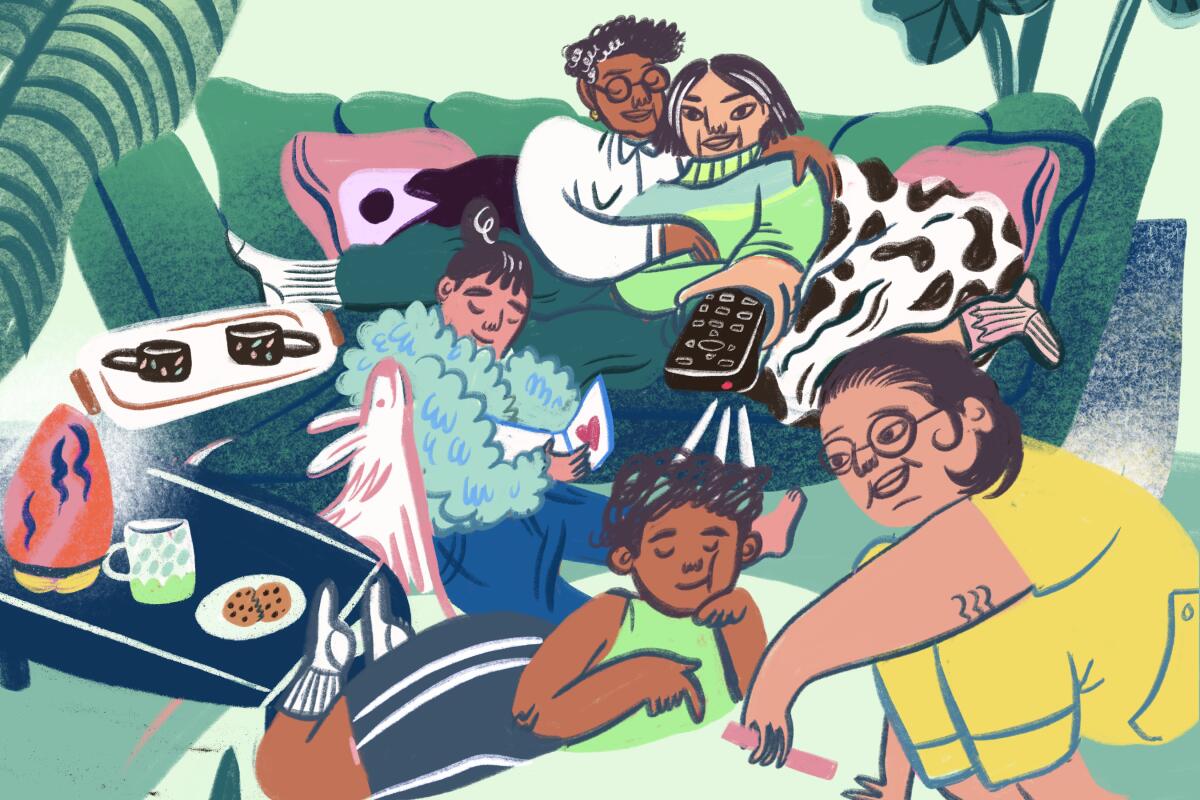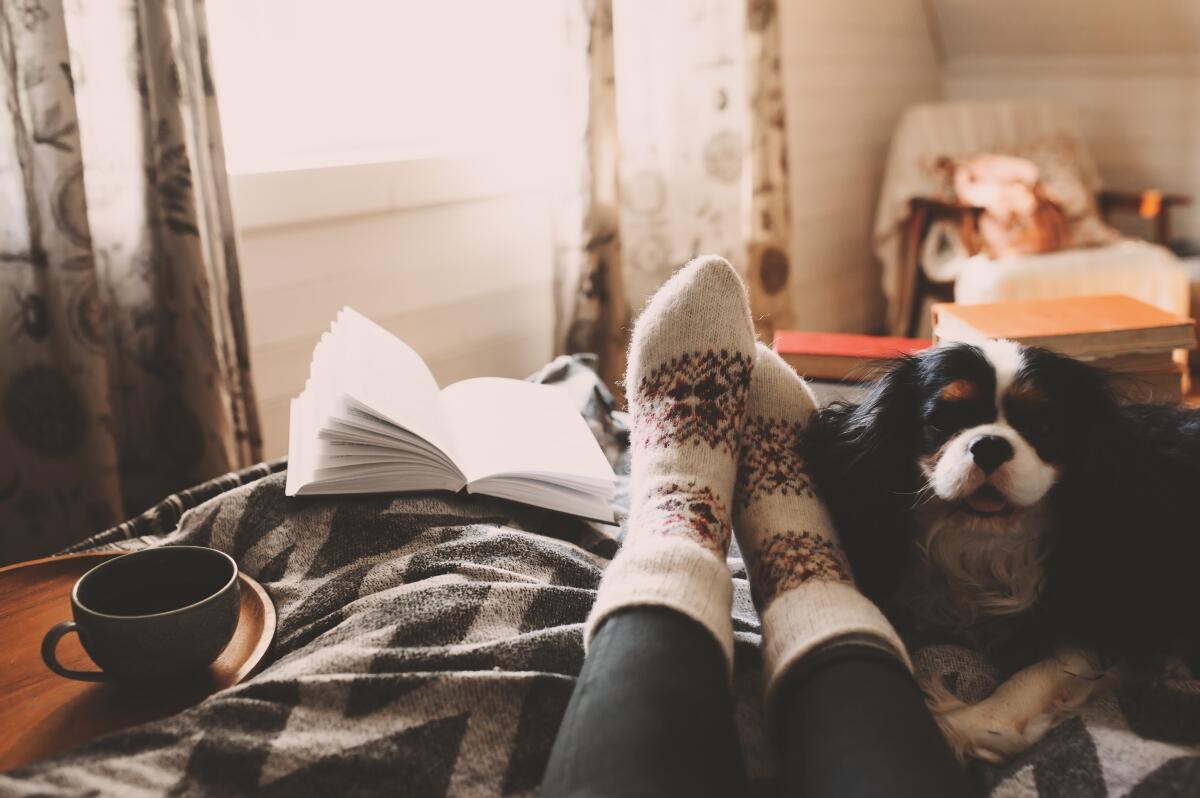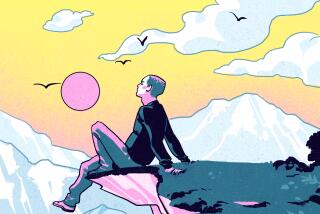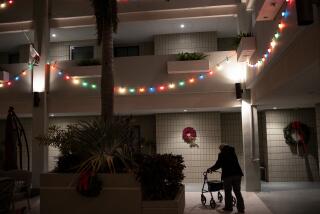The upside of social distancing: How hygge can help

- Share via
At a time of great unease, with terms like “social distancing,” “flattening the curve,” “pandemic” and, for Angelenos, “rain” embedded into our vocabularies and psyches, one Nordic word has the potential to give us hope.
Hygge.
Pronounced “hoo-gah,” like “hula” with a really excited U, “hygge is the art of creating a nice atmosphere, taking things slow and enjoying the simple pleasures of life,” said Meik Wiking, CEO of the Happiness Research Institute in Denmark and bestselling author of “The Little Book of Hygge: Danish Secrets to Happy Living.”
Derived from a Norwegian word for “well-being,” hygge also means “cozy togetherness,” “fun,” “safety and shielding from the world,” “the absence of annoyance” and the notion that your home is, literally and metaphorically, giving you a hug.
Now, more than ever, hygge is needed in our lives and homes — the concept a palpable necessity as we humbly nod to its origin. Hygge, after all, was created as a survival mechanism — an “antidote,” Wiking said, to the harsh Nordic winter and the “duvet of darkness” that envelops it.
Danes and Norwegians have been practicing this for 200 years, honing hygge as part of their national identity and culture. Perhaps that’s the reason that, despite spending half the year in darkness sequestered in their homes, these are reported to be among the happiest people in the world.
So, how do we get hygge with it? (I had to.)
Fittingly, our current isolated circumstances pose a timely opportunity to give your house (and life) a big, cozy hygge, creating a home you can celebrate, appreciate and rely on for comfort in this unsettling time.
“Home is always the place that becomes our personal sanctuary,” said the Los Angeles-based British interior designer and author Martyn Lawrence Bullard. “Comfort is modern luxury.”
So look around your abode and ask yourself what it needs. And you don’t necessarily need to shop for it.

According to “The Little Book of Hygge,” achieving comfort, along with atmosphere, presence, pleasure, equality, gratitude, harmony, truce, togetherness and shelter, is the purpose and manifesto of hygge.
A plethora of traditions have evolved from hygge, like creating a hyggekrog, a quaint, comfy relaxation nook. (My version is my purple loveseat under a window clad with a cat perch, a snoring cat and, across the room, Netflix’s birchwood edition fireplace ablaze on the TV — atmosphere, by any means.)
You can also do it by mindfully donning your hyggebukser, “that one pair of pants you would never wear in public but are so comfortable they’re likely to be, secretly, your favorites,” said Wiking. (Admit it, you’ve been wearing them. You’re still wearing them. And you love it.)
Inventing a continuous sense of magic hour in your home with candles, or levende lys (living lights), and dimly lit lamps is key to enjoying søndagshygge, Danish for a relaxing Sunday with hot beverages, good reads, music and blankets.
“Hygge is humble and slow,” Wiking said. “It is choosing rustic over new, simple over posh and ambience over excitement.”
If you’re looking for design or decor inspiration, organic elements of the natural world — like plants, wool and wood — are encouraged to echo the sweet outdoors lost to the winds of winter. Angelenos, in particular, celebrate year-round indoor/outdoor living as part of our cultural identity; more time indoors is an opportunity to appreciate nostalgia and ponder the sights, sounds, tastes and physical sensations that create a feeling and memory of hygge and hope for each of us.
“I might make a tiny Christmas tree,” said Karen Rae Kaltenborn Nothstein, a Norwegian-American screenwriter whose L.A. company, Lost for Word, adapts Scandinavian scripts for English-speaking audiences.
A Christmas tree? Even though it’s March?
“Why not?” she said. “Whatever makes you feel good when we’re going to be stuck inside.”
Christmas is the apex of hygge in Norway and Denmark, not necessarily for religious reasons, but because it occurs at the peak of darkness, the time when humans need comfort, conviviality and connectivity the most.
Suddenly, a Christmas tree in March in Los Angeles makes sense.
Togetherness, the irreplaceable purveyor of oxytocin (or the “cuddle hormone”), is the most important aspect of hygge. Right now, however, we must firmly “hold together by standing apart,” said Wiking.
And there are countless ways to do that.
In a Facebook post, I asked people to share the ways they’re practicing separate togetherness and making the most of a challenging time.
One friend meets her pals for FaceTime happy hour, others bake for their elderly neighbor and my husband fights virtual reality zombies with family back in New England. Newlyweds who missed out on a “real” honeymoon couldn’t be happier having quality time staycationing with their pets.
Hygge is the warm spirit of resilience, acceptance and joy through “a minimalist state of gratitude,” said Nothstein.
And don’t forget the snacks.
Experiencing pleasure and indulging in “something sinful is also an integral component of the hygge ritual,” said Wiking. Whether it’s chocolate, coffee, cake, sweets, mulled wine or a bowl of buttery popcorn, it’s about “giving your responsible, stressed-out achiever adult a break,” he said.
As we’re temporarily separated from loved ones, take this time to love yourself a little more.
Bullard suggests taking a bath and drinking a glass of wine out of your grandfather’s best crystal glass: “Who cares if it’s 1 p.m.! Live for today, use your stuff and enjoy yourselves in whatever ways we can.”
If succulent treats and midafternoon happy hour is a bit too Dionysian for you, do something creatively inspiring or productive you’ve been putting off (just make sure you’re having fun; chores can wait).
Los Angeles artist Katrien Van Der Schueren said she is spending time painting inside her house and that her husband and children formed a band.
“We film performances and send it to the grandparents and my European friends who are doctors on the frontline,” said the Belgian-born Van Der Schueren. “This is a lesson in humility. At the end of this, you will have a different outlook on the important things.”
Let perspective keep you present and grateful, and from this presence regain perspective once again. Put down your phone, pause, smell the hot cocoa and remember, home is where the hygge is.
More to Read
Sign up for The Wild
We’ll help you find the best places to hike, bike and run, as well as the perfect silent spots for meditation and yoga.
You may occasionally receive promotional content from the Los Angeles Times.










